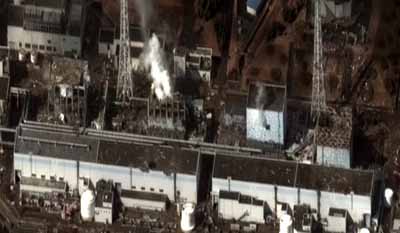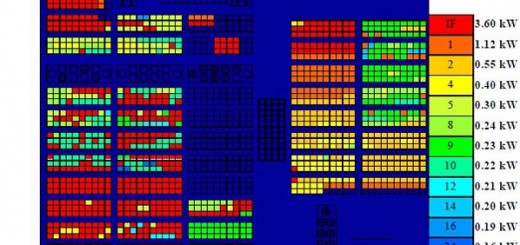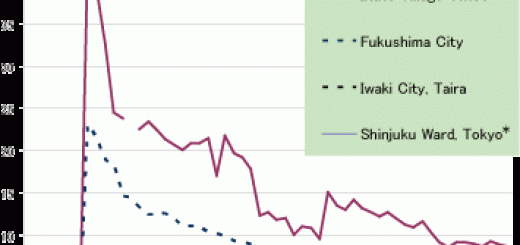Explosions at Nuclear Power Plants Tsunami Swamps Fukushima Nuclear Power Plant Nuke Info Tokyo No. 141
 |
On March 11 at 14:46, a mammoth earthquake triggered the automatic shutdown of all nuclear reactors along Japan’s northeastern Pacific coast. When the temblor struck, the Higashidori nuclear power station in Aomori prefecture was offline for inspection. At the Onagawa plant in Miyagi prefecture, three units were operating. In Fukushima prefecture, Fukushima I (also referred to as Fukushima Daiichi) had three units online and three under inspection, and at Fukushima II (also referred to as Fukushima Daini), four were active. Tokai 2’s single unit in Ibaraki prefecture was also generating power. The large tremors apparently caused all operating reactors to shut down automatically (a final determination, however, will require further scrutiny). Of these plants, Fukushima I suffered catastrophic damage.
At Fukushima I, the massive tidal wave that followed the earthquake severed the outside electric power supply, and inundating seawater disabled 13 emergency diesel generators inside the plant. The tsunami also washed away diesel fuel tanks. This damage occurred within about an hour after the earthquake, effectively incapacitating the plant’s cooling system. Technicians apparently believed that Unit 2 was in the worst shape at this point. At 21:00, Nuclear Emergency Response Headquarters** in Tokyo warned that by 21:40, the coolant level would drop, uncovering the upper part of the fuel rods. It estimated that damage to the core would begin by about 22:20, and that fuel-rod cladding would start to disintegrate by 23:50.
The subsequent emergency response was hammered out, moment by moment, to prevent a worst-case scenario: a loss of coolant leading to a full nuclear meltdown and cataclysmic disaster. At 22:30, three power-supply trucks arrived at the site, and by the following morning, many more were on hand. It is too early to know exactly how the off-site center, some 5 km away, responded at first, but mobile power units and other emergency equipment as well as Self-Defense Force (SDF) personnel were rapidly converging there.
The Emergency Response Headquarters convened its first meeting at 19:03 on March 11 and at 19:22 declared a nuclear emergency. At 21:23, Prime Minister Naoto Kan instructed local residents living within a 3 km radius of the stricken plant to evacuate the area and told those living within a 10 km radius to remain indoors. About 6,000 people were affected. At 5:44 on March 12, the evacuation zone was extended to 10 km, and at 18:25, it was enlarged once again to 20 km. At the same time, people within 10 km of the Fukushima II complex further south were also directed to leave their homes.
At just past midnight on March 12, the preliminary response seemed to be effective, and the situation appeared under control. In Unit 1, steam from the isolation condenser was cooling the core. In Unit 2, a temporary power source was maintaining the core’s water level, and in Unit 3, the reactor core isolation cooling system was pumping water into the core. Moreover, early that morning, in Units 5 and 6 a short distance away, the water flow function was found to be intact, allowing the cooling system to be restarted, and it was thought that both reactors could be stabilized.
At dawn, however, pressure inside the Unit 1 containment vessel had soared to 8.4 atmospheres, nearly double the maximum pressure it was built to withstand (4.24 atmospheres). At that point, it was feared the containment vessel, which is designed to contain radiation from the core, would rupture, and at 9:07, steam was vented into the outside air. At 10:04, fuel rods began to protrude above the surface of the coolant.
On March 12 at 15:36, just as an aftershock jolted the site from directly below, a hydrogen explosion blew away the upper story of the outer building that houses Unit 1. This was the floor where equipment for periodic inspections, refueling machinery, and a heavy-duty crane were stored. The blast was not announced until some five hours later.
When fuel rods are exposed to air, they superheat, causing the zirconium cladding to react chemically with water and release hydrogen. Hydrogen is thought to have collected in the upper part of the outer building, where a spark from metal parts jostling together in the aftershock may have ignited it. As a result of the explosion, 500 microsieverts (µSv)/hour of radiation were released into the atmosphere (the exact location of the leak has not been pinpointed). That is 10,000 times the normal background radiation level (0.04-0.08 µSv/hour).
At 20:20 that evening, emergency personnel began to pump seawater into the Unit 1 reactor. This was an extraordinary measure necessitated by loss of coolant. The water level in the core could not be restored, however, and more than one-third of the fuel rods remained exposed to the air. It is estimated that 70% of the reactor core was damaged.
On March 13, Unit 3’s emergency core cooling system also failed. Workers started spraying water on the containment vessel to bring core temperatures down. At the same time, steam was vented from the pressurized core chamber into the primary containment structure. These measures were intended to keep the fuel rods submerged. That afternoon, however, as the water continued to fall, more of the rods were exposed. From about 13:00, workers began injecting seawater into the core, but the water level did not rise, and about half the length of the 4 m rods remained uncovered. It has not been determined whether the core was seriously compromised, but the damage was probably even more extensive than at Unit 1.
Emergency personnel continued to bathe the Unit 3 core with seawater and vent steam periodically from the reactor chamber. On March 14, at 11:01, however, a second explosion erupted. The blowout was even more powerful than that at Unit 1 two days earlier. Judging from TV footage, it sent an enormous plume of steam rocketing some 300 m into the air and obliterated not only the upper section of the reactor building but also the thick concrete walls that protected its lower stories.
As a result, radioactive materials including iodine, cesium, and other rare isotopes were spewed over a wide area. On March 15, the entire Kanto plain was enveloped by contamination ranging in intensity from 20 to several hundred times the normal background radiation.
Meanwhile, at Unit 2, where workers had kept the fuel bundles under water, coolant began to recede, threatening to lay bare the rods. By the evening of March 14, the fuel was almost wholly exposed. The reactor’s outer shell consists of concrete panels that are supposed to swing outward as the pressure inside increases in order to prevent a build-up of volatile hydrogen. At Unit 2, workers freed these panels as a precautionary measure, successfully averting another blast.
At Units 1, 2, and 3, workers struggled mightily to contain the crisis amid soaring radiation levels. On March 15, Unit 4 was rocked by another huge explosion. The media reported that the upper part of the reactor building was torn apart, leaving two gaping holes in the lower half. Photos later showed that, like Units 3 and 4, most of the wall facing the ocean was gone.
Unit 4 had been under inspection when the earthquake hit, and workers were transferring superheated spent fuel from the core to the storage pool in the same building. With the cooling system disabled, however, it is thought that water in the pool evaporated, uncovering the spent fuel. It is also possible that tremors caused a significant leak, which may have hastened the accident. The exposed spent fuel produced hydrogen, triggering an explosion. At this point, a major release of radiation could no longer be avoided. Subsequently, emergency workers and SDF personnel used helicopters equipped with airdrop devices and vehicles fitted with high-pressure water hoses to douse the stricken reactor. These operations proved to be effective up to a point.
On March 15, shortly before the blowout at Unit 4, Unit 2 was shaken by a blast that partially damaged the pressure suppression chamber in its containment vessel. At Unit 3, the March 14 explosion was thought to have dented or deformed the upper section of the structure, possibly opening a crack in it. This vessel performs the vital task of bottling up core radiation in the event of an accident, but at Unit 3, that function is no longer viable.
As I write (March 22), a full-blown catastrophe has been averted for the moment. But it is too soon to say that the crisis is drawing to an end. Until electricity has effectively been restored from the outside and the plant’s operating systems are put back in order, it will continue to be touch and go. I salute the brave men and women at the site who expose themselves daily to high radiation doses as they struggle to bring this disaster under control.
By Hideyuki Ban (CNIC Co-Director)
Author’s note: These observations are based on the assumption that data provided by Nuclear Emergency Response Headquarters are more or less accurate.
**Translator’s note: In the event of a serious nuclear accident, the 1999 Act on Special Measures Concerning Nuclear Emergency Preparedness (Articles 15 to 24, Chapter III) requires the establishment of a Nuclear Emergency Response Headquarters and the declaration of a nuclear emergency.



